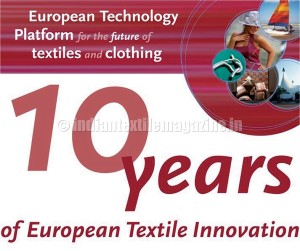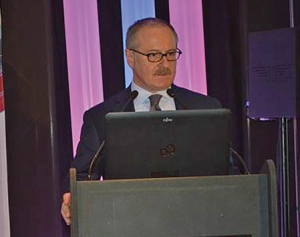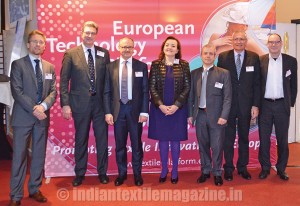 The 10th annual public conference of the European Technology Platform for the Future of Textiles and Clothing (Textile ETP) took place in Brussels on March 25 and 26. Over 150 participants from 20 countries witnessed a very broad overview of the key textile technologies which moved from research labs into industrial practice over the last 10 years or which are expected to do so over the next 10 years. It was an impressive demonstration of how innovative, high-tech and diversified the EU textile and clothing sector has become.
The 10th annual public conference of the European Technology Platform for the Future of Textiles and Clothing (Textile ETP) took place in Brussels on March 25 and 26. Over 150 participants from 20 countries witnessed a very broad overview of the key textile technologies which moved from research labs into industrial practice over the last 10 years or which are expected to do so over the next 10 years. It was an impressive demonstration of how innovative, high-tech and diversified the EU textile and clothing sector has become.
Alluding to these developments in his opening address, Mr. Paolo Canonico, President of the Technology Platform, stated: “Few people would have predicted this incredible transformation of our sector back in 2004, the year when the Textile ETP was launched and incidentally also the year when the last textile import quotas were phased out. While it is true that we lost many companies and industry jobs in the following 5-year period, the companies that have successfully navigated this phase are more competitive and resilient than before. While holding on to the majority of its turnover, the industry has increased its productivity by almost 50% and extra-EU exports have risen by one-third to over €42 billion during the last 10 years.”
Concluding his remarks, he expressed his conviction that the high-tech transformation of the sector would gather further steam in the coming decade, making the need for collaboration with the academic and applied research sectors more important and further reinforcing the role of the Technology Platform as an enabler of European networking, knowledge transfer and access to funding.
The high-level representative of the European Commission, Ms. Clara de la Torre, Director for Key Enabling Technologies, the industrial research part of the EU’s HORIZON 2020 research funding programme, highlighted the successful participation of the textile and clothing sector in EU programmes in the past 10 years.

She also stressed the crucial role that the Technology Platform has played in facilitating access to these funding opportunities, especially for SMEs, as well as enabling collaboration with other sectors. She admitted difficulties in the start-up of HORIZON 2020 mainly due to the massive oversubscription of the funding calls, and invited the Technology Platform to help finding better ways of funding research that will lead to economic growth and job creation in Europe.
The Presidents of AUTEX, the Textile Universities Association representing 28 universities with about 3,300 students in textile courses, and Textranet, the European Network of Textile Research and Technology Organisations, representing 27 institutes with over 3,700 researchers and technicians, Dominique Adolphe and Braz Costa, serving also as Vice-Presidents of the Technology Platform, stressed the important role of the academic and applied textile research institutions to ensure that the technologies for industrial breakthroughs for the next 10 years are explored, developed and successfully transferred to industry. They both confirmed that since the launch of the Textile ETP, collaboration between the industry and the textile research community has become closer and more constructive, confirming Europe as the world’s “capital of textile technology”.
Throughout the two conference days 20 presentations shared between industry, technology centres and academia, explored the most promising new technologies and innovations in areas like sustainable fibres, nanofibers, smart textiles, technical textile applications, advanced fibre and textile processing technologies, digitalisation and new business models.
At the closing session Jean-François Aguinaga, head of the textiles and fashion industry unit of the European Commission’s newly-created DG GROW, reminded participants of the overriding policy goal of the EC under President Juncker of creating economic growth and jobs, the related €315 billion investment package and various initiatives that will involve individual sectors such as textiles and clothing into the practical implementation.

EURATEX President Serge Piolat as well as speakers for the French and Italian textile and fashion industries outlined the future strategies of the federations, and remarkably all finished on a high note regarding the current business prospects showing positive sales trends based on a recovering internal market and an even stronger contribution from exports.
Closing the conference, Lutz Walter, Secretary General of the Technology Platform, provided a glimpse onto the changing environment in which the Textile ETP will operate in its second decade. While he sees exciting technology and market opportunities and an innovative and resilient industry to grasp them, he was less sanguine about the current EU support opportunities.
He vowed to address the current shortcomings of HORIZON 2020 with EU policy makers. He also suggested to better exploit the platform to identify and connected highly specific textile expertise across Europe towards a smart textile specialisation and to develop the Textile ETP into a think-tank bringing the best textile minds in Europe together in a common forum.